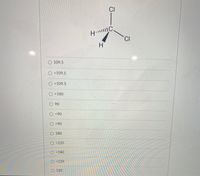
Chemistry
10th Edition
ISBN: 9781305957404
Author: Steven S. Zumdahl, Susan A. Zumdahl, Donald J. DeCoste
Publisher: Cengage Learning
expand_more
expand_more
format_list_bulleted
Concept explainers
Question
what is the Cl-C-all bond angle in the following molecule

Transcribed Image Text:CI
IC.
CI
O 109.5
O <109.5
O >109.5
O >180
90
O <90
O >90
180
>120
O <180
O <120
O 120
Expert Solution
This question has been solved!
Explore an expertly crafted, step-by-step solution for a thorough understanding of key concepts.
Step by stepSolved in 2 steps

Knowledge Booster
Learn more about
Need a deep-dive on the concept behind this application? Look no further. Learn more about this topic, chemistry and related others by exploring similar questions and additional content below.Similar questions
- Part A Below is a cartoon drawing of a seesaw molecular geometry which is based upon the trigonal bipyramidal electron group geometry. Which of the following is the best statement about the bond angle indicated by the double arrow in the diagram. The bond angle indicated is exactly 109.5° The bond angle indicated is less than 109.5° The bond angle indicated is less than 90° The bond angle indicated is less than 120°. The bond angle indicated is exactly 120°. The bond angle indicated is exactly 90° Submit Previous Answers Completed Part B The bond angle indicated in the diagram above is less than 120° Choose the best ending to this sentence. because the bonding electron pairs attract each other more, making the angle less. because the atoms at the end of the bonding pairs of electrons attract each other more. because the bonding pair of electrons making up the bond angle are attracted by the lone pair(s) of electrons on the other side of the central atom. because the lone pair(s) of…arrow_forwardAccording to the VSEPR theory, why are bonds and lone pairs spaces as far apart as possible? Thanks!arrow_forwardHow many electrons are in bonding orbitals in H2 and He2?arrow_forward
- what is the geometry around the double bonds ? from left to rightarrow_forwardconvert the following condesnsed formula into bond line structure (HCC)₂CH(CH)₂CO₂(CH₂)₂CH(CBCHOH)₂2 (HCC)₂CH(CH)₂CO₂(CH₂)2CH(CBrCHOH)2arrow_forwardWhich of the following elements are capable of expanding their octet? Select all that apply. Br Se Farrow_forward
arrow_back_ios
arrow_forward_ios
Recommended textbooks for you
 ChemistryChemistryISBN:9781305957404Author:Steven S. Zumdahl, Susan A. Zumdahl, Donald J. DeCostePublisher:Cengage Learning
ChemistryChemistryISBN:9781305957404Author:Steven S. Zumdahl, Susan A. Zumdahl, Donald J. DeCostePublisher:Cengage Learning ChemistryChemistryISBN:9781259911156Author:Raymond Chang Dr., Jason Overby ProfessorPublisher:McGraw-Hill Education
ChemistryChemistryISBN:9781259911156Author:Raymond Chang Dr., Jason Overby ProfessorPublisher:McGraw-Hill Education Principles of Instrumental AnalysisChemistryISBN:9781305577213Author:Douglas A. Skoog, F. James Holler, Stanley R. CrouchPublisher:Cengage Learning
Principles of Instrumental AnalysisChemistryISBN:9781305577213Author:Douglas A. Skoog, F. James Holler, Stanley R. CrouchPublisher:Cengage Learning Organic ChemistryChemistryISBN:9780078021558Author:Janice Gorzynski Smith Dr.Publisher:McGraw-Hill Education
Organic ChemistryChemistryISBN:9780078021558Author:Janice Gorzynski Smith Dr.Publisher:McGraw-Hill Education Chemistry: Principles and ReactionsChemistryISBN:9781305079373Author:William L. Masterton, Cecile N. HurleyPublisher:Cengage Learning
Chemistry: Principles and ReactionsChemistryISBN:9781305079373Author:William L. Masterton, Cecile N. HurleyPublisher:Cengage Learning Elementary Principles of Chemical Processes, Bind...ChemistryISBN:9781118431221Author:Richard M. Felder, Ronald W. Rousseau, Lisa G. BullardPublisher:WILEY
Elementary Principles of Chemical Processes, Bind...ChemistryISBN:9781118431221Author:Richard M. Felder, Ronald W. Rousseau, Lisa G. BullardPublisher:WILEY

Chemistry
Chemistry
ISBN:9781305957404
Author:Steven S. Zumdahl, Susan A. Zumdahl, Donald J. DeCoste
Publisher:Cengage Learning

Chemistry
Chemistry
ISBN:9781259911156
Author:Raymond Chang Dr., Jason Overby Professor
Publisher:McGraw-Hill Education

Principles of Instrumental Analysis
Chemistry
ISBN:9781305577213
Author:Douglas A. Skoog, F. James Holler, Stanley R. Crouch
Publisher:Cengage Learning

Organic Chemistry
Chemistry
ISBN:9780078021558
Author:Janice Gorzynski Smith Dr.
Publisher:McGraw-Hill Education

Chemistry: Principles and Reactions
Chemistry
ISBN:9781305079373
Author:William L. Masterton, Cecile N. Hurley
Publisher:Cengage Learning

Elementary Principles of Chemical Processes, Bind...
Chemistry
ISBN:9781118431221
Author:Richard M. Felder, Ronald W. Rousseau, Lisa G. Bullard
Publisher:WILEY